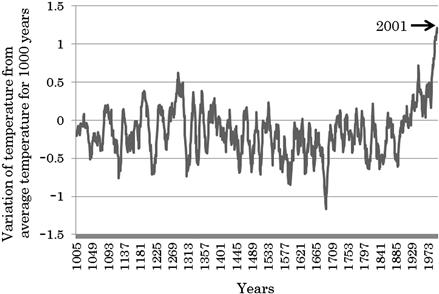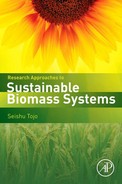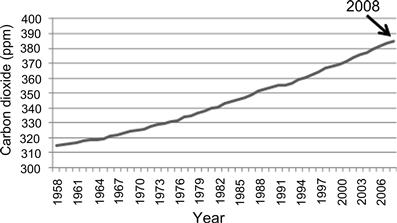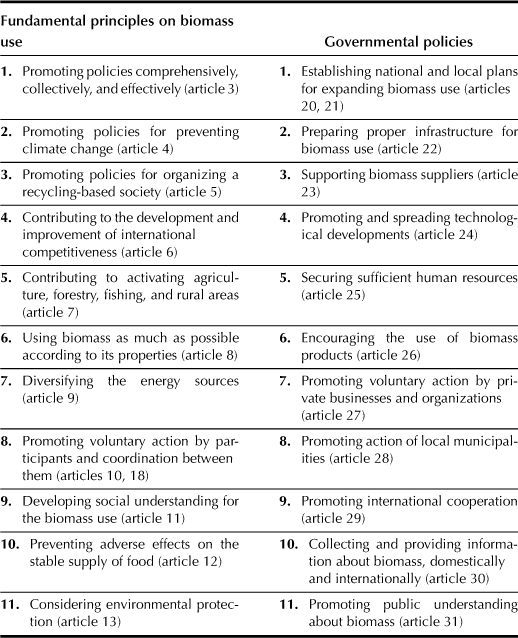Background of Bioenergy Utilization Development in Japan
Tadashi Yokoyama and Hiroshi Yoshida
Abstract
Increasing public concern about climate change over the last couple of decades has motivated the government of Japan to promote the production of bioenegy as alternatives for fossil fuel. This chapter provides the societal background and principal policies for the promotion of bionergy utilization in Japan, with a brief depiction of the issue concerning global warning caused by human activities.
Keywords
Climate change; global temperature; greenhouse gases; IPCC; Kyoto Protocol; Biomass Nippon Strategy; Basic Law on the Promotion of Biomass Utilization; Basic Plan for the Promotion of Biomass Utilization
Chapter Outline
1.1 Environmental Change with Human Activities
Tadashi Yokoyama
In recent times, the global temperature and carbon dioxide level in the atmosphere have increased rapidly. Although over at least the last 650,000 years, atmospheric temperatures and carbon dioxide levels have periodically increased and decreased in a cyclical pattern (Jouzel et al., 2007), many people feel that today’s climate change is different from previous climate changes based on several observations such as the remarks issued by the US Environment Protection Agency (EPA) on current climate change. First, none of the natural causes of climate change, including variations in the Sun’s energy and the Earth’s orbit, can fully explain the observed climate changes. Second, burning huge quantities of fossil fuels, including coal, oil, and natural gas, to satisfy domestic and industrial energy needs is overloading the atmosphere with carbon dioxide that contributes to the greenhouse effect. Human activities are also adding other heat-trapping greenhouse gases (GHGs), such as methane and nitrous oxide, to the atmosphere. For hundreds of thousands of years, the concentration of carbon dioxide in the atmosphere stayed between 200 and 300 parts per million; however, today it has increased to nearly 400 parts per million, and is still rising. Along with other GHGs, this extra atmospheric carbon dioxide is trapping solar heat to cause climate change (http://www.epa.gov/climatechange/science/indicators/weather-climate/).
Figure 1.1 illustrates a thousand-year record of temperature variations for Germany and Central Europe based on documentary data obtained from Glaser and Reimann (2009); it suggests that after around 1900, temperature has certainly increased from the baseline that represents the average temperature for the past 1000 years in Central Europe. Figure 1.2 shows the average carbon dioxide concentration in December in Manua Los, Hawaii (Keeling et al., 2009). In 1958, the atmospheric carbon dioxide averaged 314.67 ppmv; it increased 22.4% to 385.02 ppmv in 2008 over a period of 50 years.

FIGURE 1.1 A thousand-year record of temperature variations for Germany and Central Europe. (Source: Glaser and Riemann, 2009.)
The conference held in Villach, Austria, 1985 was regarded as an important milestone in the international climate change debate. A major scientific assessment, “The role of carbon dioxide and of other greenhouse gases (GHGs) in climate variations and associated impacts”, presented at the conference was based on the investigation made by a small group of environmental scientists and research managers associated with nongovernmental organizations from 1983 to 1985. A general conclusion of the conference is the anticipation of an unprecedented rise of global mean temperature during the first half of the twenty-first century.
With the scientific evidence accumulated, climate change appeared to be one of the important challenges to future economic prosperity in the international community during the late 1980s. In 1988, the Intergovernmental Panel on Climate Change (IPCC) was established jointly by the World Meteorological Organization and United Nations Environment Program. The IPCC emphasized that the emissions resulting from human activities may be changing the Earth’s climate in its first assessment report published in 1990 (Houghton et al., 1990). In the wake of increased concerns about environmental issues, including global warning, the United Nations Conference on Environment and Development (UNCED) was held in Rio de Janeiro, Brazil in June 1992. This conference, also known as the Earth Summit, led to the United Nations Framework Convention on Climate Change (UNFCCC), together with the Rio Declaration on Environment and Development and other documents also known as “Agenda 21”. The ultimate objective of the UNFCCC is to stabilize the atmospheric GHG concentrations at a level that would prevent dangerous anthropogenic interference with Earth’s climate system. Subsequently, the Kyoto Protocol, which set a target to reduce GHG emissions by 5.2% below the 1990 levels by 2012, was agreed upon as a protocol of the UNGCCC in December 1997. However, it was not until February 2005 that the Protocol eventually entered into force after long negotiations among the parties involved (United Nations, 1998). Industrialized countries are required to ratify and implement the Protocol in order to reduce GHG emissions below the quantified targets assigned to each country during the first commitment period (2008–2012).
1.2 Japanese Biomass Utilization Policy
Hiroshi Yoshida
According to the Kyoto Protocol, Japan needs to achieve a 6% reduction of GHG emissions to prompt the government of Japan to reconsider its energy policy (Government of Japan, 2006). Based on various responses and inputs from the general public during the 1970s, the government decided to promote the utilization of biomass fuel because it is a carbon-neutral energy source. The first oil crisis in 1973 also aroused public interest in the use of biomass energy; however, the widespread use of biomass has not been realized because the government prioritized the development of nuclear power or natural gas in the national energy policy. The promotion of biomass utilization in Japan since the early 2000s has been motivated not only by GHG emissions reduction but also by other issues. First, international crude oil prices substantially increased during the early 2000s, which motivated the development of renewable energy sources as alternatives for foreign oil. Second, recycling organic wastes such as animal waste, sewage sludge, and other biomass disposals is urgently needed in accordance with the national move to construct a recycle-oriented society. Third, the effective utilization of abundant biomass resources available in rural areas is expected to revitalize rural economies that have been adversely affected during the long recession by generating new industries and jobs in rural regions. With increasing public concerns over these issues, the government of Japan established the Biomass Nippon Strategy (BNS) in 2002 (MAFF, 2009).
The BNS has four ultimate goals: (i) the prevention of global warning; (ii) the creation of a recycling-oriented society; (iii) the promotion of new competitive strategic industries for bioproducts, biofuel and biopower; and (iv) the revitalization of the agricultural, forestry, and fisheries industries as well as local communities. In line with these goals, initial specific targets were laid out, with 2002 as the base year and 2010 as the target year. These targets include increasing (i) biofuel use for the transportation sector from virtually zero to 500,000 KL (crude oil basis); (ii) biomass energy use capacity from 68,000 KL to 3.08 million KL; and (iii) the recovery rate of unused biomass materials from 20% to more than 25%.
In 2009, the government enacted the Basic Law on the Promotion of Biomass Utilization by addressing fundamental principles, defining responsibilities of the concerned institutions, and setting the fundamental conditions of the policy for comprehensive biomass utilization. Table 1.1 summarizes the fundamental principles on biomass utilization and governmental policies of this law. Because the Basic Law addresses only the conceptual framework of policies, detailed policies are defined in the “Basic Plan for the Promotion of Biomass Utilization” established in 2010. The Basic Plan has provided basic strategies and various action plans to improve the performance of biomass-related projects with three specific objectives: (i) the revitalization of 600 local communities by establishing local biomass plans; (ii) the strengthening of international competency by achieving 500 billion yens of output in biomass-related industries; and (iii) the prevention of climate change and creation of a recycling-oriented society by achieving 26 million tons of carbon equivalents of emission reductions.
References
1. Glaser R, Riemann D. A thousand year record of climate variation for Central Europe at a monthly resolution. Journal of Quaternary Science. 2009;24:437–449.
2. Government of Japan. Baiomasu nippon sogo senryaku (Biomass nippon comprehensive strategy). 2006; <http://www.maff.go.jp/j/biomass/pdf/h18senryaku.pdf>; 2006; Accessed 29.06.2012 [in Japanese].
3. Houghton JT, Jenkins GJ, Ephraums JJ, eds. Climate change: The IPCC scientific assessment Report prepared for Intergovernmental Panel on Climate Change by Working Group I. Cambridge: Cambridge University Press; 1990; <http://www.ipcc.ch/ipccreports/far/wg_I/ipcc_far_wg_I_full_report.pdf>; 1990; Accessed 11.06.2012.
4. Jouzel J, Masson-Delmotte V, Cattani O, et al. Orbital and Millennial Antarctic Climate Variability over the Past 800,000 Years. Science. 2007;317(5839):793–796.
5. Keeling RF, Piper SC, Bollenbacher AF, Walker JS. Atmospheric Carbon Dioxide Record from Mauna Loa. 2009; <http://cdiac.ornl.gov/trends/co2/sio-mlo.html>; 2009; doi: 10.3334/CDIAC/atg.035, 2009.
6. Ministry of Agriculture. Forestry, and Fisheries (MAFF). Japan: Japanese biomass policy; 2009; <http://www.biomass-asia-workshop.jp/biomassws/06workshop/presentation/01Saigou.pdf>; 2009; [in Japanese].
7. United Nations. Kyoto Protocol to the United Nations Framework on Climate Change. 1998; <http://unfccc.int/resource/docs/convkp/kpeng.pdf>; 1998; Accessed 20.06.2012.
8. United Nations Framework Convention on Climate Change (UNFCC). <http://unfccc.int/essential_background/items/6031.php>; Accessed 20.06.2012.


